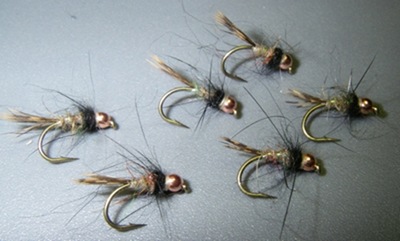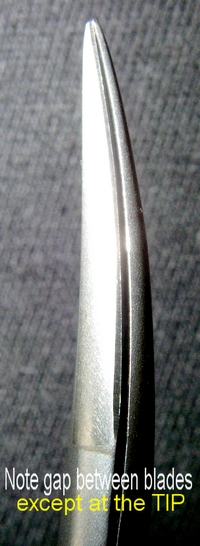 Very little is ever written about commercial fly tiers, mostly they’re a vanishing breed, due in large part to the overseas fly tying trade. Domestic production is still a cottage industry with each shop a blend of local and offshore flies.
Very little is ever written about commercial fly tiers, mostly they’re a vanishing breed, due in large part to the overseas fly tying trade. Domestic production is still a cottage industry with each shop a blend of local and offshore flies.
The “Professional” fly tyer is another matter entirely, plenty of them around, although most would balk at that label. Professional isn’t about the money it’s about the time spent tying, and if you tie an hour or more daily, you’re a candidate.
Tying multiple hours a night needs to be treated like a business even if it’s a passion. You’ve outgrown that leftover, hand me down, garage sale setup you cobbled together, and aren’t willing to come to grips with what you need. Storage and tools have always been priorities for a professional tier, yet they always take a back seat to buying more materials.
Fly tiers are incapable of tying in comfort, they’ll drop $300 on chicken feathers without batting an eyelash, then sit on a stack of newspapers while tying.
The lifeblood of any serious tyer is his vise and scissors, no other tools are as important to his craft, nor have as much affect on the finished product. Vise choice is very much individualistic, with much press and opinion on the relative merits of assorted manufacturers, necessary features, and rotating gadgets.
What’s never talked about is scissors and why 95% of all fly tiers use crap. It’s a “rogue’s gallery” of awkward potmetal scissors from India, small “pinking” shears sold in craft shops, or whatever they stole from their wife’s sewing chest.
Craft store scissors and small sewing scissors are made for women, they have small finger holes not suitable for hammy male fingers. They’re rarely available in sizes beyond 4″ in length, and despite having “fine” points, are meant to cut cloth, thread, and yarn – at the base of the scissor not at the points.
Fly shop scissors will suit a beginner fine, the $12.00 investment for a set of Dr. Slick’s doesn’t harm a new tier much, leaving him budget for the important stuff – the endless parade of materials he’ll need to build the flies.
Professional tiers need two sets of scissors; a heavy “shear” scissor for cutting great hunks of bucktail and other unruly materials, and a fine point scissor designed to cut at the tip, for the precise cuts – like clearing a hook eye of fiber.
These scissors have been available for decades, but fly tiers rarely encounter them unless they’re a surgeon or doctor. Thousands of styles of precision scissors exist in the medical community, each shape and size designed for cutting different types of tissue, and depending on the task, they’re designed to cut at the tips, base, or the entire cutting edge.
Eye surgery needs precise tips, none of the surgery slices heavy bone or thick connective tissue. Eyeball components are delicate and scissors designed for an eye surgeon are precision instruments for tiny slices. Many are available with tungsten inserts, one of the hardest steel alloys available, allowing for razor sharp edges and precise cuts. Tungsten is also one of the most brittle steel alloys, and if you catch the hook shank with an errant slice you can remove the tip of the scissors completely.
Bill Hunter of Hunter’s Angling Supplies, was the first to introduce these scissors to the tying community, he described them as “cosmetic seconds” from the medical industry, and the retail was about $100 per set. He always warned prospective owners about the tungsten inserts and how cuts should be practiced before blindly whacking away.
The trick is to slide the scissors down fibers to the point of the cut rather than push the point into the area you wished to trim. Like you will, I learned the hard way, yet it quickly becomes second nature. Scissors of this quality will allow the points inside the hook eye, which means you have to be careful, and like any med student you should practice.
Dr. Slick scissors imitate medical scissors, down to the gold colored handles. Medical scissors are not “gold colored” it’s real gold, as it’s both antiseptic and malleable it’ll eventually scrape off the stainless handles.
Medical scissors are available in a dizzying assortment of sizes, and can be purchased to accommodate the largest of hands. The smallest I would use is the 4.5″ length, it’s among the most common sizes available and like all medical scissors, has wide finger eyelets so that you aren’t having to cram big fingers into too small an opening. Surgery can last many hours, and these precision tools are designed not to be fatiguing to the user.
Buy semi-curved versus straight scissors. Semi-curved allows the tips to make the cut without your fingers and wrist obscuring the cut area. Straight scissors require the hand to be in the same plane as the cut – often that mass of fingers and wrist can get in the way of your vision, with Tungsten inserts that’s a bad thing, one careless cut and you’re pissed.
Cheap semi-curved scissors are designed for toe nails with the blade curving from base to tip, too much curvature to be really useful. Medical semi-curved scissors start their curve midway down the blade, a much gentler curvature that you will instantly prefer. (Note the accompanying pictures)
The larger “shear” scissors can be the traditional straight edge. You’ll be using it to cut big chunks of deer hair and fur off hides, where there’s little reason to be delicate or restrained. Many prefer a serrated edge on the shears as serration prevents material from sliding away from the cutting edge, these require practice as well; serrated edges cut positively everything and lack forgiveness – it’ll take some getting used to as it’s a marked difference from traditional smooth edge scissors.
The below photograph shows the Ophthalmology scissors I purchased from Bill Hunter and other medical supply houses. Each set has been used for nearly 20 years, due to their precision manufacture each will last a lifetime.

Do the math. With precision vises costing nearly $400, there’s little to complain about, a vise is used once per fly yet the scissors are used 10-12 times per fly. I’d rather buy a vise for $300 and a set of scissors for $100, a more efficient use of hard earned coin.
Medical supply houses abound on the Internet, and if you live in a major city you can visit and paw through them to pick the length, taper, and edge that suits your tying best.
The links included in the article demonstrate some of the range of points and styles available. Each of the scissors types can be further researched once the “name” of the style you like is chosen. “Metzenbaum” and “Iris” are consistent across the medical community, all you have to do is Google the style name to find all the variations and prices.
Technorati Tags: Iris scissors, Ophthalmology scissors, fly tying scissors, semi-curved blade, tungsten carbide insert

 offers 15 hours of glow time. I see this as an interesting experiment, call it “Thread that makes you go, ‘Hmmm'” Colors: Blue, Classic, Green, Orange, Pink, Purple, White, Yellow. 120 denier, 2ply (sounds like yarn) $13.95 for 1100 yards.
offers 15 hours of glow time. I see this as an interesting experiment, call it “Thread that makes you go, ‘Hmmm'” Colors: Blue, Classic, Green, Orange, Pink, Purple, White, Yellow. 120 denier, 2ply (sounds like yarn) $13.95 for 1100 yards. 5.
5. 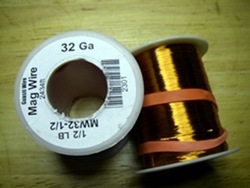 I use more copper wire than the Intel Corporation, and my recent whirlwind tour of fly shops gave me a shopping list of items to find in bulk . Copper wire was first on the list, as a measly 30 foot spool costs $2.00 at the shop.
I use more copper wire than the Intel Corporation, and my recent whirlwind tour of fly shops gave me a shopping list of items to find in bulk . Copper wire was first on the list, as a measly 30 foot spool costs $2.00 at the shop.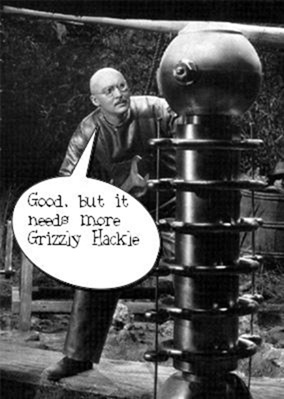 A fly tyer is responsible for the entire sub-prime mortgage debacle, and the proof is on my tying bench.
A fly tyer is responsible for the entire sub-prime mortgage debacle, and the proof is on my tying bench.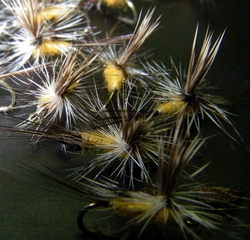
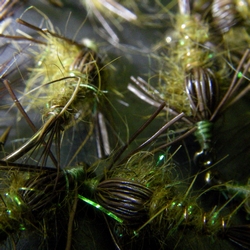 Not having to give them all away is a first, normally all the fishing pals show up at my door with their hand out. No matter how many I tie up I am left with two after the feeding frenzy.
Not having to give them all away is a first, normally all the fishing pals show up at my door with their hand out. No matter how many I tie up I am left with two after the feeding frenzy.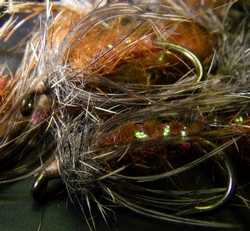 October Caddis in case they’re needed, if not these will make a nice carp fly, heavy wire hook and ribbed with Angelina to add a dab of flash.
October Caddis in case they’re needed, if not these will make a nice carp fly, heavy wire hook and ribbed with Angelina to add a dab of flash.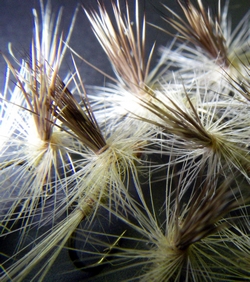 The Pale Olive Paraduns were spared my fiddling with the recipe, in large part because in my youth I had to tie 200-300 dozen of them per year. It’s quite possible I was asleep when I tied these, as were the only pattern that escaped augmentation.
The Pale Olive Paraduns were spared my fiddling with the recipe, in large part because in my youth I had to tie 200-300 dozen of them per year. It’s quite possible I was asleep when I tied these, as were the only pattern that escaped augmentation.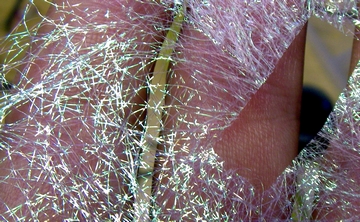 This fabric is only as strong as the volume of fibers used and the degree of their overlap. Additional experimentation is required to find the best pattern to melt; parallel fibers, cross-hatched, further testing is needed to determine what proves strongest.
This fabric is only as strong as the volume of fibers used and the degree of their overlap. Additional experimentation is required to find the best pattern to melt; parallel fibers, cross-hatched, further testing is needed to determine what proves strongest.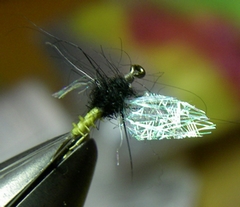
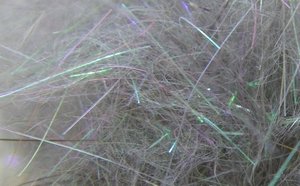

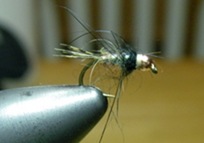 I am whipping together some flies for tomorrow’s Brownline Tarpon session, still giddy from today’s success. I left four flies in bull rushes or fish and realized I was getting low on the physical properties needed.
I am whipping together some flies for tomorrow’s Brownline Tarpon session, still giddy from today’s success. I left four flies in bull rushes or fish and realized I was getting low on the physical properties needed.